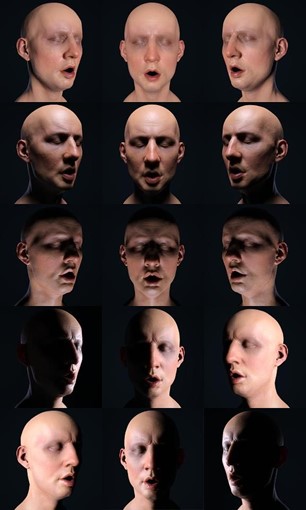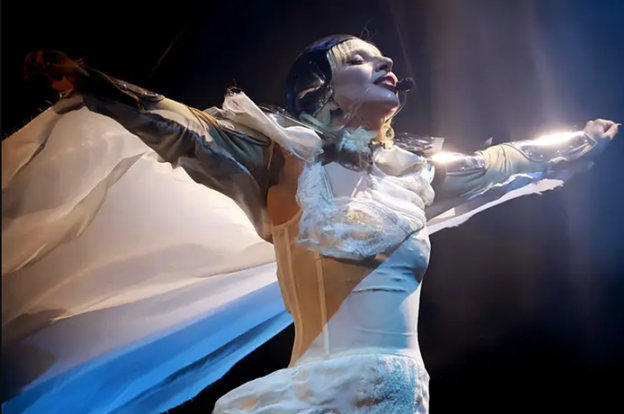Stage Lighting & Makeup: How Does Lighting Affect Makeup?
At Coachella 2025, Post Malone’s sun-kissed glow and Jennie’s dewy highlighter looked flawless under the desert sky—but step offstage, and the magic shifts. Under normal light, festival makeup can appear overly dramatic or even patchy. High-output lamps and uncalibrated color temperatures can distort pigments, turning a contoured masterpiece into a washed-out blur.
That’s why top artists and lighting designers obsess over reflection angles, CRI (Color Rendering Index), and precision lens filters, ensuring facial depth stays intact from every camera angle. Whether it’s Lady Gaga’s sharp contour under a spotlight or Tyla’s shimmer catching a golden-hour beam, the right stage lighting doesn’t just illuminate; it transforms makeup into a living, breathing art. Keep scrolling to see how the idols and artists’ makeup collabs with stage lighting.
The Role of Stage Lighting in Performance
Enhancing Visual Definition through Lighting Design
Strategic fixture placement sculpts an actor’s silhouette by manipulating contrast and beam angles. For example, low-angle backlighting sharpens hair and shoulder outlines, drawing attention to facial expressions. Programmable LED arrays take this further, offering precise dimming curves and transitions. This adds dimensionality without overpowering the scene.
Colorful Lights and Facial Detail
While saturated hues (like deep magenta) create dramatic impact, they can distort natural skin tones and obscure subtle facial details. To counteract this, designers use balanced fill lights to preserve micro-expressions and contouring. In stage lighting, blending complementary gel colors ensures performers remain recognizable, even under complex, multi-colored schemes.
Temperature of Light and Makeup Appearance
A foundation or eyeshadow can look drastically different under tungsten (warm) and daylight-balanced (cool) lighting. For instance, a warm-toned foundation may appear ashy under cool washes. High-CRI (Color Rendering Index) LEDs mitigate this issue, maintaining makeup’s true vibrancy across varying lighting conditions.
How Different Stage Lighting Conditions Affect Makeup
Below, we break down how different lighting scenarios impact makeup and why high-quality, adjustable lighting is essential for flawless visuals.
Warm vs. Cool Light Colour Temperatures
Stage lighting varies in color temperature, measured in Kelvin (K). The wrong temperature can make makeup look unnatural or even disappear under harsh beams.
Warm Light (2700 K- 3500 K – Yellow/Orange Tones)
- Enhances golden and peachy makeup tones but can make cool-toned makeup (like ashy contour or blue-based red lipstick) look muddy.
- Without proper balancing, warm light may cause the foundation to appear too orange.
Cool Light (5000 K- 6500 K – Blue/White Tones)
- Can wash out warm-toned makeup (like bronzer or coral blush), making skin look pale or gray.
- Bright, cool lighting highlights imperfections (like uneven blending or texture).
Colourful Stage Lighting
Dramatic RGB (Red, Green, Blue) lighting creates stunning visual effects, but can also distort makeup if not properly managed.
- Deep Red & Magenta Lights can amplify warm tones (red lips look more intense) but may cancel out cool colors (like purple eyeshadow).
- Blue & Green Tones can make skin look sickly or washed out if not balanced with neutral fill lights.
Intensity and Shadows
- High-lumen fixtures create sharp contrasts that emphasise facial planes and texture.
- Strong side lighting can inflate cheek hollows or deepen fine lines beyond normal appearances.
- Under extreme angles, contour placements, highlight intensities, and powder finishes balance the look.

Makeup Tips for Different Stage Lighting Designs
| Color/Type | Makeup Recommendations |
|---|---|
| Warm (Yellow/White) | Colors appear truer and more flattering. Use your standard stage makeup, but ensure blush and lipstick are not too muted. |
| Cool (Blue/Purple) | Blue light dulls reds and pinks, making them appear gray or lifeless. Use lighter, more reflective foundations and more obvious highlights to avoid a flat look. Tone down reds and oranges, as they absorb blue light and can look muddy or overly dark. Consider using pinks with a touch of coral or peach for blush and lips to maintain vibrancy. |
| Orange/Amber | Orange lighting intensifies reds, so use more subdued or neutral reds for blush and lipstick to avoid an overpowering effect. Avoid overly warm foundations, as they can look too orange under these lights. |
| Mixed/Colorful Lighting | Test your makeup under similar lighting before performances if possible. Adapt blush and lip colors to the dominant stage light color. Use matte products to avoid unwanted shine, which can be exaggerated by colored lights. |
How to Select Stage Lighting Gear with Makeup in Mind
Selecting stage lighting gear is crucial because the quality, color, and intensity of lighting directly affect how makeup appears to the audience. Here’s a table for a summary. Below are the detailed explanations to help you make informed choices:
| Scope | Why It Matters for Makeup | Recommendation |
|---|---|---|
| Color Temperature | Accurate color rendering | 4800–5000K (daylight) |
| Intensity | Visibility and feature definition | 1000–1400 lumens |
| Adjustability | Fine-tuning for scenes and faces | Dimmable, angle-adjustable |
| Color Mixing | Flexibility for different scenes | Supports gels or digital mixing |
| Heat Output | Comfort and makeup durability | Prefer LED over incandescent |
| Safety | Reliable, accident-free operation | Proper wiring and mounting |
Prioritize Lighting Quality and Color Temperature
Choose fixtures that offer a color temperature close to natural daylight (4800–5000 kelvins). This range provides the most accurate rendering of makeup colors and skin tones, preventing unwanted color shifts that can make makeup look unnatural.
Avoid lighting that is overly yellow (incandescent) or green (fluorescent), as these can distort makeup colors—red lipstick may look dull under greenish lighting, and purple eyeshadow can be washed out by yellowish lights.
Ensure Sufficient Intensity and Coverage
Select lighting instruments that provide enough intensity (1000–1400 lumens is recommended for makeup application and visibility).
Use front lighting as your primary source to ensure performers’ faces are clearly visible, but balance it with side and backlighting to avoid a flat, washed-out appearance and to create depth.
Opt for Versatile, Adjustable Fixtures
Choose lights with adjustable angles and dimming capabilities. This allows you to fine-tune the lighting for different scenes, moods, and makeup looks, ensuring that facial features remain defined without harsh shadows or overexposure.
LED fixtures are a good choice as they produce less heat, minimizing makeup melting and actor discomfort, while offering flexible color mixing options.
Plan for Color Mixing and Scene Changes
Use lighting gear that supports color gels or digital color mixing. This enables you to adapt the lighting for various scenes and costumes, ensuring makeup remains flattering under all conditions.
Test makeup under the actual stage lights before performances to identify any color distortions or intensity issues, and adjust both lighting and makeup as needed.

Safety and Practical Considerations
Ensure your lighting setup is safely wired and powered, and that fixtures are securely mounted.
Consider the heat output of your lighting gear—LEDs are preferable for comfort and makeup longevity.
Light Sky Stage Lighting Gears for the Flawless Performance
For anyone seeking reliable and versatile stage lighting solutions, Light Sky offers a comprehensive range of professional lighting gear designed to meet the demands of modern performances. Our product lineup includes advanced moving beams, washes, lasers, and spotlights to provide both high-quality color rendering and flexible control options.
For more information about professional stage lighting designs, visit our website or contact us today.









